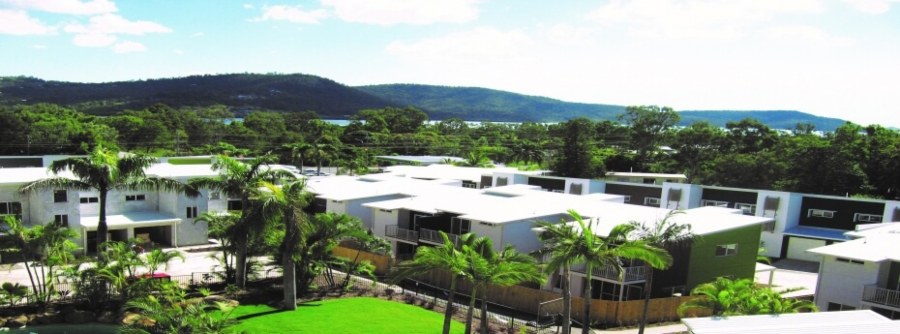What is the right colour and what is allowable under the NCC?
Our buildings’ colour palette today is very different to that of 50 years ago. The Australia of the 1950’s & 60’s had lots of red brick walls and dark coloured roofs, reminiscent of the colours of a much colder climate.
These changes are part of a natural process of evolution of trends in our society, but to a larger degree reflect the adaptation of our architecture to better suit the Australian climate, as well as our greater awareness of the impact this will have on the health of our environment. Designs that take advantage of natural air flow for instance, and colours that help absorb or reflect the heat depending on the climate zone are some of the many factors influencing this change.
Since the late 1990’s there has been a shift away from dark colours, particularly for roofing. This has been championed by changes in the BlueScope Steel colour palette over this period and also changes to acceptable building practices under the NCC.
This process has continued with the latest changes introduced in NCC Volume One for commercial roofs and Volume Two for residential roofs and walls. Dark coloured roofs will no longer be permitted under the Deemed to Satisfy (DtS) provisions. Commercial buildings will need a light-coloured roof, with all climate zones (except for Climate Zone 8) requiring a maximum solar absorptance of 0.45 to comply. This means that any commercial roof assessed under the DtS provisions will need to be Surfmist®, Classic Cream™, Paperbark®, Shale Grey™ or Evening Haze®. All medium or dark coloured roofs, including “green” roofs, dark concrete and membrane roofs require a performance-based solution to demonstrate compliance. For residential buildings in climate zones 1 to 4, the solar absorptance of the upper surface of a roof must not be more than 0.64, the solar absorptance of the outer surface of a wall must not be more than 0.7.
| Deemed to Satisfy | Performance Solution |
| Bondor Metecno Insulated Penels: acceptable external roof skin colours based on BlueScope's guidelines on max skin temperature | ||||
|---|---|---|---|---|
| Exposure Category | ||||
| 1 | 2 | 3 | 4 | |
|
EPS-FR core (< 80°C) |
Classic Cream™ | Classic Cream™ | Classic Cream™ | Classic Cream™ |
| Surfmist® | Surfmist® | Surfmist® | Surfmist® | |
| Paperbark® | Paperbark® | Paperbark® | Paperbark® | |
| Shale Grey™ | Shale Grey™ | Shale Grey™ | Shale Grey™ | |
| Dune® | Dune® | Dune® | Dune® | |
| Pale Eucalypt®^ | Pale Eucalypt® | Pale Eucalypt® | Pale Eucalypt® | |
| Manor Red®^ | Manor Red®^ | Manor Red® | Manor Red® | |
| Basalt®^ | Basalt®^ | Basalt® | Basalt® | |
| Woodland Grey®^ | Woodland Grey®^ | Woodland Grey®^ | Woodland Grey® | |
| Exposure Category | ||||
| 1 | 2 | 3 | 4 | |
|
PIR core (< 100°C) |
Classic Cream™ | Classic Cream™ | Classic Cream™ | Classic Cream™ |
| Surfmist® | Surfmist® | Surfmist® | Surfmist® | |
| Paperbark® | Paperbark® | Paperbark® | Paperbark® | |
| Shale Grey™ | Shale Grey™ | Shale Grey™ | Shale Grey™ | |
| Dune® | Dune® | Dune® | Dune® | |
| Pale Eucalypt® | Pale Eucalypt® | Pale Eucalypt® | Pale Eucalypt® | |
| Manor Red® | Manor Red® | Manor Red® | Manor Red® | |
| Basalt® | Basalt® | Basalt® | Basalt® | |
| Woodland Grey® | Woodland Grey® | Woodland Grey® | Woodland Grey® | |
So, what is Solar Absorptance?
Solar Absorptance (SA) is the fraction of the total incident solar radiation that is absorbed by the roofing material, with the remainder being reflected. SA is expressed as a ratio between 0 and 1. A roof with a lower SA will absorb less heat, compared to a roof with a higher SA, which will help in keeping the roof space and the building cooler.
For detailed information on NCC Volumes One and Two please refer to the ABCB website. Volume One of NCC primarily regulates multi-residential, commercial, industrial and public assembly buildings and some associated structures. NCC Volume One requires the Solar Absorptance of the upper surface of the roof to be less than or equal to 0.45 for the DtS pathway. Roof surfaces with SA greater than 0.45 must use the Performance Solution pathway to compliance.
What does this mean for insulated panel colours?
Bondor Metecno are guided by the NCC and the BlueScope’s recommendations for appropriate colours, with the addition of special requirements specific to insulated panel. Bondor Metecno panels acceptable external colours based on COLORBOND’s guidelines of maximum skin temperature can be seen below
| Bondor Metecno panel's acceptable external roof skin Solar absorptance values based on BlueScope's guidelines on max skin temperatures | ||||
|---|---|---|---|---|
| Application | Roof - max solar absorptance value | |||
| Panel Type | Exposure Category | |||
| 1 | 2 | 3 | 4 | |
|
EPS-FR (< 80°C) |
0.54 | 0.62 | 0.69 | 0.75 |
|
Mineral Wool and PIR (< 100°C) |
0.75 | 0.96 | 0.96 | 0.96 |
Exposure category 1 | Exposure category 3 |
|---|---|
Wilcannia, Oodnadatta, Swan Hill, Mardie | Toowoomba, Mackay, Cooma, Port Stephens, Omeo, Gladstone, Bowral, Lithgow, Bright |
Exposure category 2 | Exposure category 4 |
|---|---|
Melbourne, Sydney, Brisbane, Townsville, Adelaide, Perth, Cairns | Hobart, Launceston, Devonport |



